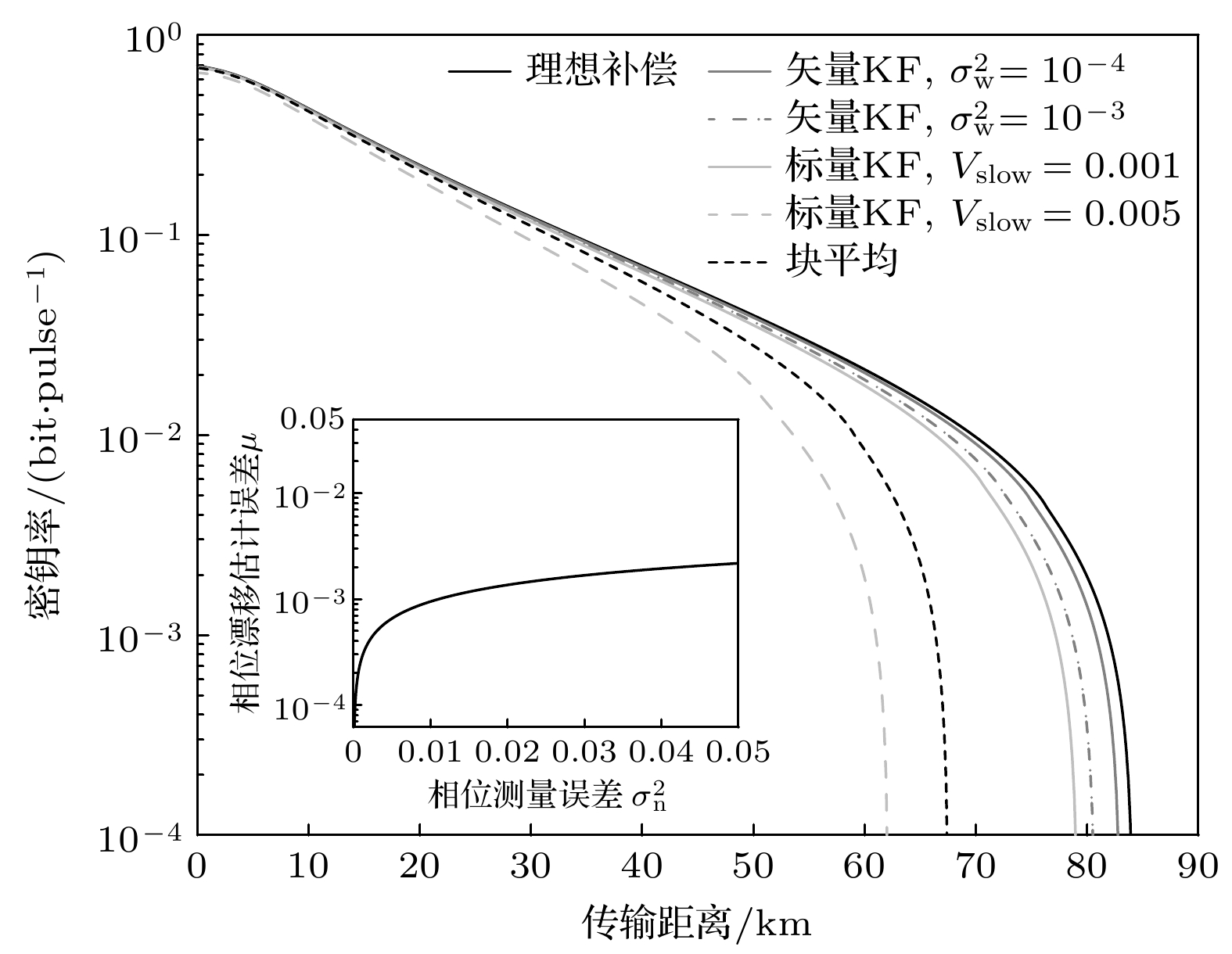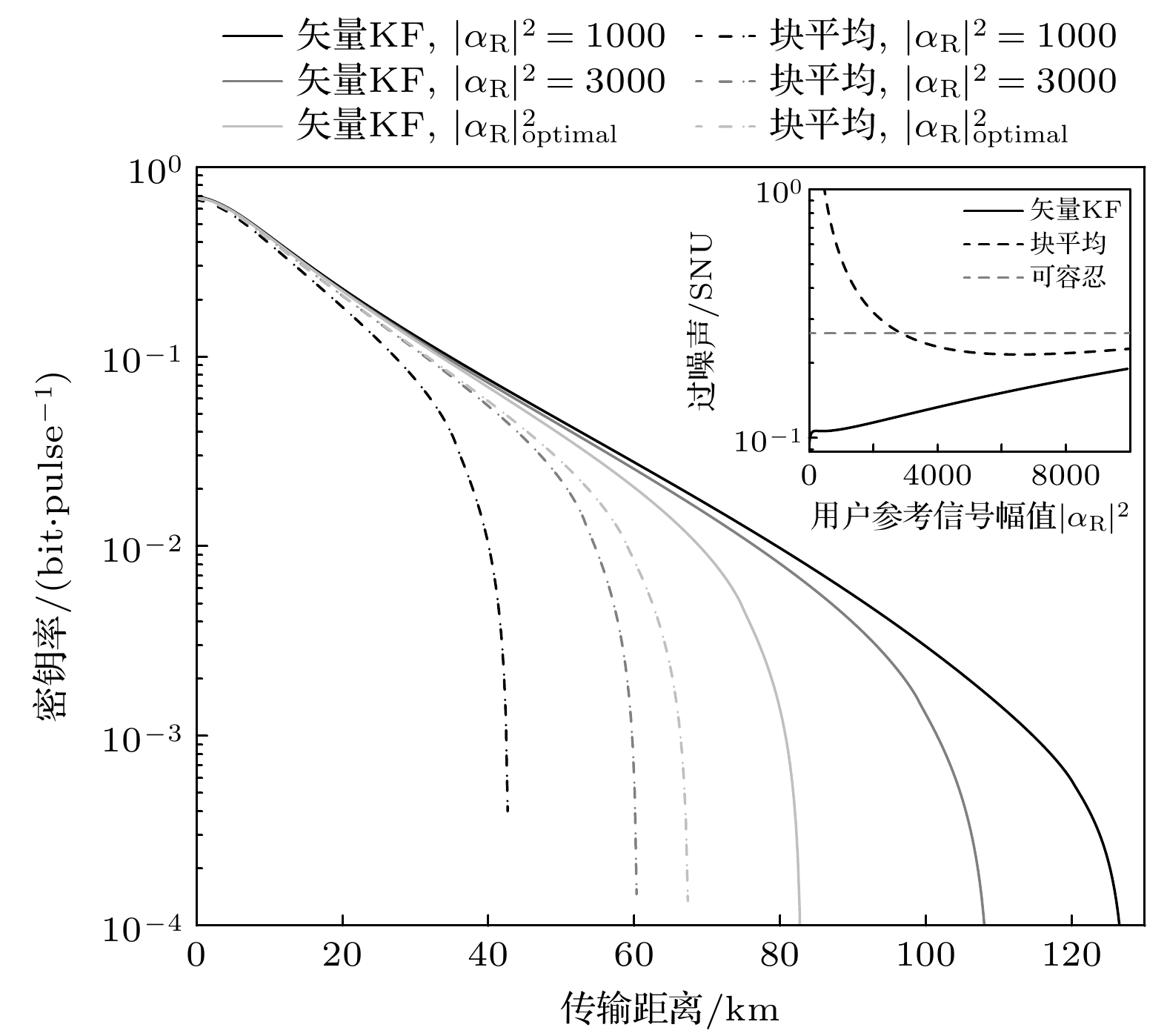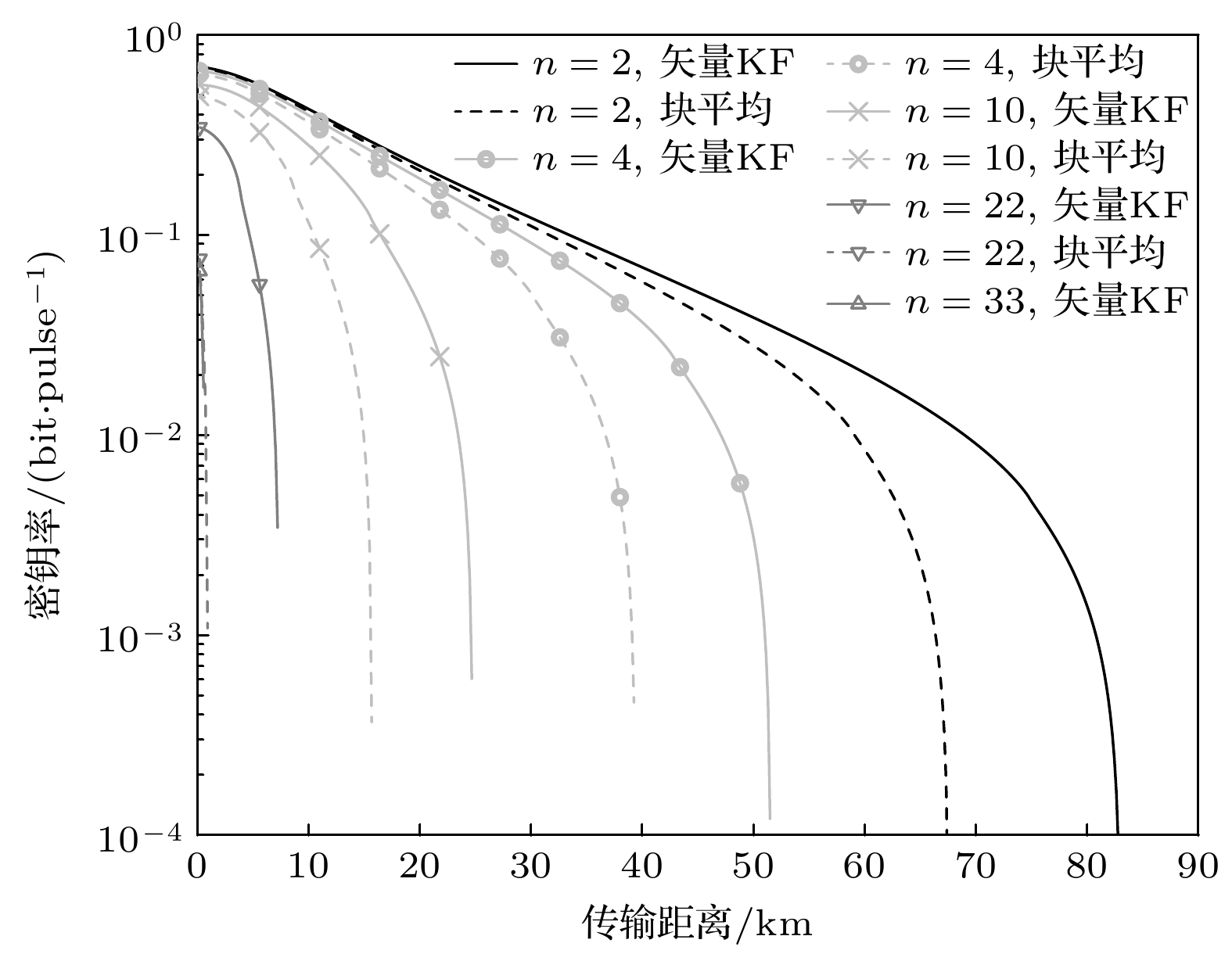-
在实际的连续变量量子秘密共享系统中, 经不安全信道传输的本振光或因各种针对性攻击而受到安全威胁. 针对这个问题, 本文提出了一种本地本振连续变量量子秘密共享方案, 本振光在可信端本地生成而无需由各用户发送, 从而彻底堵住相关安全漏洞. 在此基础上, 利用卡尔曼滤波对各个参考相位分别进行最小均方误差估计, 在降低相位漂移估计误差的同时抑制相位测量噪声. 分别开发了涉及标量卡尔曼和矢量卡尔曼的相位补偿方法, 其中矢量卡尔曼一步完成补偿而无需额外处理相位慢漂移. 本文对滤波后系统的过噪声进行建模, 并推导了针对窃听者和不诚实用户的安全界限. 数值模拟结果表明, 与块平均相比, 所提方案在最大传输距离和最大支持用户数方面优势明显, 具有构建大规模量子通信网络的潜力.In a practical continuous-variable quantum secret sharing system, the local oscillator transmitted via an insecure channel may be subjected to security threats due to various targeted attacks. To solve this problem, this paper proposes a continuous-variable quantum secret sharing scheme with local intrinsic oscillator, in which the intrinsic oscillator is generated locally at the trusted end without being sent by each user, thus completely plugging the relevant security loopholes. The scheme consists of three stages: preparation, where users generate Gaussian-modulated coherent states and reference signals; measurement, where the dealer performs heterodyne detection by using the local intrinsic oscillator and reference phases; post-processing, which involves parameter estimation, phase compensation, and secure key extraction. On this basis, Kalman filter (KF) is utilized to estimate the minimum mean square error for each reference phase separately, reducing the phase drift estimation error and suppressing the phase measurement noise. Phase compensation methods for scalar KF and vector KF are developed respectively, where scalar KF requires additional block averaging for slow phase drift, while vector KF simultaneously models fast and slow drifts, enabling one-step compensation with minimized estimation errors. The excess noise of the filtered system including modulation noise, phase noise, photon leakage noise, and ADC quantization noise is modeled, with KF reducing phase measurement noise via dynamic gain optimization. Security bound against eavesdroppers and dishonest users is derived. Numerical simulations under practical parameters demonstrate significant improvements: vector KF achieves a maximum transmission distance of 82.6 km (vs. 67.3 km for block averaging) and supports 33 users (vs. 22), with excess noise reduced by 40% at 60 km. The scheme’s robustness is further validated under varying reference signal amplitudes, showing stable performance even at lower levels, minimizing interference with quantum signals. These results highlight that the proposed scheme has significant advantages in terms of maximum transmission distance and maximum number of supported users, and has the potential to build adaptive KF algorithms for dynamic user scenarios and quantum machine learning integration.
-
Keywords:
- quantum secret sharing /
- continuous variable /
- local local oscillator /
- Kalman filter
[1] Hillery M, Bužek V, Berthiaume A 1999 Phys. Rev. A 59 1829
 Google Scholar
Google Scholar
[2] Karlsson A, Koashi M, Imoto N 1999 Phys. Rev. A 59 162
 Google Scholar
Google Scholar
[3] Tyc T, Sanders B C 2002 Phys. Rev. A 65 042310
 Google Scholar
Google Scholar
[4] Lance A M, Symul T, Bowen W P, Tyc T, Sanders B C, Lam P K 2003 New J. Phys. 5 4
 Google Scholar
Google Scholar
[5] Liao Q, Xiao G, Xu C G, Xu Y, Guo Y 2020 Phys. Rev. A 102 032604
 Google Scholar
Google Scholar
[6] Kogias I, Xiang Y, He Q, Adesso G 2017 Phys. Rev. A 95 012315
 Google Scholar
Google Scholar
[7] Grice W P, Qi B 2019 Phys. Rev. A 100 022339
 Google Scholar
Google Scholar
[8] Wang Y J, Jia B, Mao Y, Wu X L, Guo Y 2020 Appl. Sci. 10 2411
 Google Scholar
Google Scholar
[9] Liao Q, Liu H J, Zhu L J, Guo Y 2021 Phys. Rev. A 103 032410
 Google Scholar
Google Scholar
[10] Liao Q, Liu X Q, Ou B, Fu X Q 2023 IEEE Trans. Commun. 71 6051
 Google Scholar
Google Scholar
[11] Liao Q, Wang Z, Liu H, Mao Y, Fu X 2022 Phys. Rev. A 106 022607
 Google Scholar
Google Scholar
[12] Ma X C, Sun S H, Jiang M S, Liang L M 2013 Phys. Rev. A-Atom. Mol. Opt. Phy. 87 052309
 Google Scholar
Google Scholar
[13] Jouguet P, Kunz-Jacques S, Diamanti E 2013 Phys. Rev. A-Atom. Mol. Opt. Phy. 87 062313
 Google Scholar
Google Scholar
[14] Ma X C, Sun S H, Jiang M S, Liang L M 2013 Phys. Rev. A-Atom. Mol. Opt. Phy. 88 022339
 Google Scholar
Google Scholar
[15] Zhao Y J, Zhang Y C, Huang Y D, Xu B J, Yu S, Guo H 2018 J. Phys. B-At. Mol. Opt. Phy. 52 015501
 Google Scholar
Google Scholar
[16] 郑异, 黄鹏, 彭进业, 曾贵华 2019 信息通信技术与政策 45 43
 Google Scholar
Google Scholar
Zheng Y, Huang P, Peng J Y, Zeng G H 2019 Inf. Commun. Technol. Policy 45 43
 Google Scholar
Google Scholar
[17] Liao Q, Huang L, Fei Z Y, Fu X Q 2025 Adv. Quantum Technol. 8 2400505
 Google Scholar
Google Scholar
[18] Kunz-Jacques S, Jouguet P 2015 Phys. Rev. A 91 022307
 Google Scholar
Google Scholar
[19] Mao Y Y, Huang W T, Zhong H, Wang Y J, Qin H, Guo Y, Huang D 2020 New J. Phys. 22 083073
 Google Scholar
Google Scholar
[20] Liao Q, Liu H J, Gong Y P, Wang Z, Peng Q Q, Guo Y 2022 Opt. Express 30 3876
 Google Scholar
Google Scholar
[21] Qi B, Lougovski P, Pooser R, Grice W, Bobrek M 2015 Phys. Rev. X 5 041009
 Google Scholar
Google Scholar
[22] Wang T, Huang P, Zhou Y M, Liu W Q, Ma H X, Wang S Y, Zeng G H 2018 Opt. Express 26 2794
 Google Scholar
Google Scholar
[23] Wang H, Li Y, Pi Y D, Pan Y, Shao Y, Ma L, Zhang Y C, Yang J, Zhang T, Huang W, Xu B J 2022 Commun. Phys. 5 162
 Google Scholar
Google Scholar
[24] Marie A, Alléaume R 2017 Phys. Rev. A 95 012316
 Google Scholar
Google Scholar
[25] Wang H, Pi Y D, Huang W, Li Y, Shao Y, Yang J, Liu J L, Zhang C L, Zhang Y C, Xu B J 2020 Opt. Express 28 32882
 Google Scholar
Google Scholar
[26] Zhang Y C, Bian Y M, Li Z Y, Yu S, Guo H 2024 Appl. Phys. Rev. 11 011318
 Google Scholar
Google Scholar
[27] 黄彪, 麻甜甜, 黄永梅, 彭真明 2021 激光与光电子学进展 58 1127001
 Google Scholar
Google Scholar
Huang B, Ma T T, Huang Y M, Peng Z M 2021 Laser Optoelectron. Prog. 58 1127001
 Google Scholar
Google Scholar
[28] Roy S, Petersen I R, Huntington E H 2015 New J. Phys. 17 063020
 Google Scholar
Google Scholar
[29] 刘旭超, 温佳旭, 李少波, 李华贵, 孙时伦 2023 中国激光 50 1412002
 Google Scholar
Google Scholar
Liu X C, Wen J X, Li S B, Li H G, Sun S L 2023 Chin. J. Lasers 50 1412002
 Google Scholar
Google Scholar
[30] Shen T, Wang X Y, Chen Z Y, Tian H P, Yu S, Guo H 2023 IEEE Photonics J. 15 7600109
 Google Scholar
Google Scholar
[31] Ren S J, Kumar R, Wonfor A, Tang X K, Penty R, White I 2019 JOSA B 36 B7
 Google Scholar
Google Scholar
[32] 黄彪, 黄永梅, 彭真明 2019 光学学报 39 1127001
 Google Scholar
Google Scholar
Huang B, Huang Y M, Peng Z M 2019 Acta Opt. Sin. 39 1127001
 Google Scholar
Google Scholar
[33] Roy S, Rehman O U, Petersen I R, Huntington E H 2014 European Control Conference Strasbourg, France pp896-901
 Google Scholar
Google Scholar
[34] Wang T, Huang P, Wang S Y, Zeng G H 2019 Opt. Express 27 26689
 Google Scholar
Google Scholar
[35] Hajomer A A, Derkach I, Jain N, Chin H M, Andersen U L, Gehring T 2024 Sci. Adv. 10 eadi9474
 Google Scholar
Google Scholar
[36] Su Y, Guo Y, Huang D 2019 Phys. Lett. A 383 2394
 Google Scholar
Google Scholar
[37] Huang B, Huang Y M, Peng Z M 2020 Opt. Express 28 28727
 Google Scholar
Google Scholar
[38] Zhong H, Ye W, Zuo Z Y, Huang D, Guo Y 2022 Opt. Express 30 5981
 Google Scholar
Google Scholar
[39] Diamanti E, Leverrier A 2015 Entropy 17 6072
 Google Scholar
Google Scholar
[40] Inoue T, Namiki S 2014 Opt. Express 22 15376
 Google Scholar
Google Scholar
[41] Huang B, Huang Y M, Peng Z M 2019 Opt. Express 27 20621
 Google Scholar
Google Scholar
[42] Shao Y, Pan Y, Wang H, Pi Y D, Li Y, Ma L, Zhang Y C, Huang W, Xu B J 2022 Entropy 24 992
 Google Scholar
Google Scholar
[43] Shao Y, Wang H, Pi Y D, Huang W, Li Y, Liu J L, Yang J, Zhang Y C, Xu B J 2021 Phys. Rev. A 104 032608
 Google Scholar
Google Scholar
[44] Kish S P, Villaseñor E, Malaney R, Mudge K A, Grant K J 2021 IEEE International Conference on Communications Montreal, Quebec pp1–6
 Google Scholar
Google Scholar
[45] Shao Y, Li Y, Wang H, Pan Y, Pi Y D, Zhang Y C, Huang W, Xu B J 2022 Phys. Rev. A 105 032601
 Google Scholar
Google Scholar
[46] Wang T, Huang P, Zhou Y M, Liu W Q, Zeng G H 2018 Phys. Rev. A 97 012310
 Google Scholar
Google Scholar
[47] Huang P, Lin D K, Huang D, Zeng, G H 2015 Int. J. Theor. Phys. 54 2613-2622
 Google Scholar
Google Scholar
[48] Jouguet P, Kunz-Jacques S, Diamanti E, Leverrier A 2012 Phys. Rev. A-Atom. Mol. Opt. Phy. 86 032309
 Google Scholar
Google Scholar
[49] Huang D, Huang P, Lin D K, Zeng G H 2016 Sci. Rep. 6 19201
 Google Scholar
Google Scholar
[50] Chin H M, Jain N, Zibar D, Andersen U L, Gehring T 2021 Npj Quantum Inf. 7 20
 Google Scholar
Google Scholar
[51] Sun Y H, Chen Z Y, Wang X Y, Yu S, Guo H 2025 Phys. Rev. Appl. 23 014056
 Google Scholar
Google Scholar
[52] Oruganti A N, Derkach I, Filip R, Usenko V C 2025 Quantum Sci. Technol. 10 025023
 Google Scholar
Google Scholar
[53] Liu Y M, Jiang X Q, Dai J S, Hai H, Huang P 2025 Quantum Sci. Technol. 10 025043
 Google Scholar
Google Scholar
[54] Liao Q, Fei Z Y, Huang L, Fu X Q 2025 Commun. Phys. 8 138
 Google Scholar
Google Scholar
[55] Ren S J, Yang S, Wonfor A, White I, Penty R 2021 Sci. Rep. 11 9454
 Google Scholar
Google Scholar
[56] Soh D B, Brif C, Coles P J, Lütkenhaus N, Camacho R M, Urayama J, Sarovar M 2015 Phys. Rev. X 5 041010
 Google Scholar
Google Scholar
[57] Lodewyck J, Bloch M, García-Patrón R, Fossier S, Karpov E, Diamanti E, Debuisschert T, Debuisschert T, Cerf N J, Tualle-Brouri R, McLaughlin S W, Grangier P 2007 Phys. Rev. A-Atom. Mol. Opt. Phy. 76 042305
 Google Scholar
Google Scholar
[58] Rui X, He H W, Sun F C, Zhao K 2013 IEEE Trans. Veh. Technol. 62 108
 Google Scholar
Google Scholar
[59] Liao Q, Fei Z Y, Liu J Y, Huang A Q, Huang L, Wang Y J 2025 Chaos Soliton. Fract. 196 116331
 Google Scholar
Google Scholar
-
图 3 不同参考信号幅值下所提方案与块平均方案性能; 小图为传输距离60 km时系统过噪声与$ {\left| {{\alpha _{\text{R}}}} \right|^2} $的函数关系
Fig. 3. Performance of the proposed scheme and block averaging for different reference signal amplitudes, and the small figure shows the excess noise as a function of $ {\left| {{\alpha _{\text{R}}}} \right|^2} $ at a transmission distance of 60 km.
-
[1] Hillery M, Bužek V, Berthiaume A 1999 Phys. Rev. A 59 1829
 Google Scholar
Google Scholar
[2] Karlsson A, Koashi M, Imoto N 1999 Phys. Rev. A 59 162
 Google Scholar
Google Scholar
[3] Tyc T, Sanders B C 2002 Phys. Rev. A 65 042310
 Google Scholar
Google Scholar
[4] Lance A M, Symul T, Bowen W P, Tyc T, Sanders B C, Lam P K 2003 New J. Phys. 5 4
 Google Scholar
Google Scholar
[5] Liao Q, Xiao G, Xu C G, Xu Y, Guo Y 2020 Phys. Rev. A 102 032604
 Google Scholar
Google Scholar
[6] Kogias I, Xiang Y, He Q, Adesso G 2017 Phys. Rev. A 95 012315
 Google Scholar
Google Scholar
[7] Grice W P, Qi B 2019 Phys. Rev. A 100 022339
 Google Scholar
Google Scholar
[8] Wang Y J, Jia B, Mao Y, Wu X L, Guo Y 2020 Appl. Sci. 10 2411
 Google Scholar
Google Scholar
[9] Liao Q, Liu H J, Zhu L J, Guo Y 2021 Phys. Rev. A 103 032410
 Google Scholar
Google Scholar
[10] Liao Q, Liu X Q, Ou B, Fu X Q 2023 IEEE Trans. Commun. 71 6051
 Google Scholar
Google Scholar
[11] Liao Q, Wang Z, Liu H, Mao Y, Fu X 2022 Phys. Rev. A 106 022607
 Google Scholar
Google Scholar
[12] Ma X C, Sun S H, Jiang M S, Liang L M 2013 Phys. Rev. A-Atom. Mol. Opt. Phy. 87 052309
 Google Scholar
Google Scholar
[13] Jouguet P, Kunz-Jacques S, Diamanti E 2013 Phys. Rev. A-Atom. Mol. Opt. Phy. 87 062313
 Google Scholar
Google Scholar
[14] Ma X C, Sun S H, Jiang M S, Liang L M 2013 Phys. Rev. A-Atom. Mol. Opt. Phy. 88 022339
 Google Scholar
Google Scholar
[15] Zhao Y J, Zhang Y C, Huang Y D, Xu B J, Yu S, Guo H 2018 J. Phys. B-At. Mol. Opt. Phy. 52 015501
 Google Scholar
Google Scholar
[16] 郑异, 黄鹏, 彭进业, 曾贵华 2019 信息通信技术与政策 45 43
 Google Scholar
Google Scholar
Zheng Y, Huang P, Peng J Y, Zeng G H 2019 Inf. Commun. Technol. Policy 45 43
 Google Scholar
Google Scholar
[17] Liao Q, Huang L, Fei Z Y, Fu X Q 2025 Adv. Quantum Technol. 8 2400505
 Google Scholar
Google Scholar
[18] Kunz-Jacques S, Jouguet P 2015 Phys. Rev. A 91 022307
 Google Scholar
Google Scholar
[19] Mao Y Y, Huang W T, Zhong H, Wang Y J, Qin H, Guo Y, Huang D 2020 New J. Phys. 22 083073
 Google Scholar
Google Scholar
[20] Liao Q, Liu H J, Gong Y P, Wang Z, Peng Q Q, Guo Y 2022 Opt. Express 30 3876
 Google Scholar
Google Scholar
[21] Qi B, Lougovski P, Pooser R, Grice W, Bobrek M 2015 Phys. Rev. X 5 041009
 Google Scholar
Google Scholar
[22] Wang T, Huang P, Zhou Y M, Liu W Q, Ma H X, Wang S Y, Zeng G H 2018 Opt. Express 26 2794
 Google Scholar
Google Scholar
[23] Wang H, Li Y, Pi Y D, Pan Y, Shao Y, Ma L, Zhang Y C, Yang J, Zhang T, Huang W, Xu B J 2022 Commun. Phys. 5 162
 Google Scholar
Google Scholar
[24] Marie A, Alléaume R 2017 Phys. Rev. A 95 012316
 Google Scholar
Google Scholar
[25] Wang H, Pi Y D, Huang W, Li Y, Shao Y, Yang J, Liu J L, Zhang C L, Zhang Y C, Xu B J 2020 Opt. Express 28 32882
 Google Scholar
Google Scholar
[26] Zhang Y C, Bian Y M, Li Z Y, Yu S, Guo H 2024 Appl. Phys. Rev. 11 011318
 Google Scholar
Google Scholar
[27] 黄彪, 麻甜甜, 黄永梅, 彭真明 2021 激光与光电子学进展 58 1127001
 Google Scholar
Google Scholar
Huang B, Ma T T, Huang Y M, Peng Z M 2021 Laser Optoelectron. Prog. 58 1127001
 Google Scholar
Google Scholar
[28] Roy S, Petersen I R, Huntington E H 2015 New J. Phys. 17 063020
 Google Scholar
Google Scholar
[29] 刘旭超, 温佳旭, 李少波, 李华贵, 孙时伦 2023 中国激光 50 1412002
 Google Scholar
Google Scholar
Liu X C, Wen J X, Li S B, Li H G, Sun S L 2023 Chin. J. Lasers 50 1412002
 Google Scholar
Google Scholar
[30] Shen T, Wang X Y, Chen Z Y, Tian H P, Yu S, Guo H 2023 IEEE Photonics J. 15 7600109
 Google Scholar
Google Scholar
[31] Ren S J, Kumar R, Wonfor A, Tang X K, Penty R, White I 2019 JOSA B 36 B7
 Google Scholar
Google Scholar
[32] 黄彪, 黄永梅, 彭真明 2019 光学学报 39 1127001
 Google Scholar
Google Scholar
Huang B, Huang Y M, Peng Z M 2019 Acta Opt. Sin. 39 1127001
 Google Scholar
Google Scholar
[33] Roy S, Rehman O U, Petersen I R, Huntington E H 2014 European Control Conference Strasbourg, France pp896-901
 Google Scholar
Google Scholar
[34] Wang T, Huang P, Wang S Y, Zeng G H 2019 Opt. Express 27 26689
 Google Scholar
Google Scholar
[35] Hajomer A A, Derkach I, Jain N, Chin H M, Andersen U L, Gehring T 2024 Sci. Adv. 10 eadi9474
 Google Scholar
Google Scholar
[36] Su Y, Guo Y, Huang D 2019 Phys. Lett. A 383 2394
 Google Scholar
Google Scholar
[37] Huang B, Huang Y M, Peng Z M 2020 Opt. Express 28 28727
 Google Scholar
Google Scholar
[38] Zhong H, Ye W, Zuo Z Y, Huang D, Guo Y 2022 Opt. Express 30 5981
 Google Scholar
Google Scholar
[39] Diamanti E, Leverrier A 2015 Entropy 17 6072
 Google Scholar
Google Scholar
[40] Inoue T, Namiki S 2014 Opt. Express 22 15376
 Google Scholar
Google Scholar
[41] Huang B, Huang Y M, Peng Z M 2019 Opt. Express 27 20621
 Google Scholar
Google Scholar
[42] Shao Y, Pan Y, Wang H, Pi Y D, Li Y, Ma L, Zhang Y C, Huang W, Xu B J 2022 Entropy 24 992
 Google Scholar
Google Scholar
[43] Shao Y, Wang H, Pi Y D, Huang W, Li Y, Liu J L, Yang J, Zhang Y C, Xu B J 2021 Phys. Rev. A 104 032608
 Google Scholar
Google Scholar
[44] Kish S P, Villaseñor E, Malaney R, Mudge K A, Grant K J 2021 IEEE International Conference on Communications Montreal, Quebec pp1–6
 Google Scholar
Google Scholar
[45] Shao Y, Li Y, Wang H, Pan Y, Pi Y D, Zhang Y C, Huang W, Xu B J 2022 Phys. Rev. A 105 032601
 Google Scholar
Google Scholar
[46] Wang T, Huang P, Zhou Y M, Liu W Q, Zeng G H 2018 Phys. Rev. A 97 012310
 Google Scholar
Google Scholar
[47] Huang P, Lin D K, Huang D, Zeng, G H 2015 Int. J. Theor. Phys. 54 2613-2622
 Google Scholar
Google Scholar
[48] Jouguet P, Kunz-Jacques S, Diamanti E, Leverrier A 2012 Phys. Rev. A-Atom. Mol. Opt. Phy. 86 032309
 Google Scholar
Google Scholar
[49] Huang D, Huang P, Lin D K, Zeng G H 2016 Sci. Rep. 6 19201
 Google Scholar
Google Scholar
[50] Chin H M, Jain N, Zibar D, Andersen U L, Gehring T 2021 Npj Quantum Inf. 7 20
 Google Scholar
Google Scholar
[51] Sun Y H, Chen Z Y, Wang X Y, Yu S, Guo H 2025 Phys. Rev. Appl. 23 014056
 Google Scholar
Google Scholar
[52] Oruganti A N, Derkach I, Filip R, Usenko V C 2025 Quantum Sci. Technol. 10 025023
 Google Scholar
Google Scholar
[53] Liu Y M, Jiang X Q, Dai J S, Hai H, Huang P 2025 Quantum Sci. Technol. 10 025043
 Google Scholar
Google Scholar
[54] Liao Q, Fei Z Y, Huang L, Fu X Q 2025 Commun. Phys. 8 138
 Google Scholar
Google Scholar
[55] Ren S J, Yang S, Wonfor A, White I, Penty R 2021 Sci. Rep. 11 9454
 Google Scholar
Google Scholar
[56] Soh D B, Brif C, Coles P J, Lütkenhaus N, Camacho R M, Urayama J, Sarovar M 2015 Phys. Rev. X 5 041010
 Google Scholar
Google Scholar
[57] Lodewyck J, Bloch M, García-Patrón R, Fossier S, Karpov E, Diamanti E, Debuisschert T, Debuisschert T, Cerf N J, Tualle-Brouri R, McLaughlin S W, Grangier P 2007 Phys. Rev. A-Atom. Mol. Opt. Phy. 76 042305
 Google Scholar
Google Scholar
[58] Rui X, He H W, Sun F C, Zhao K 2013 IEEE Trans. Veh. Technol. 62 108
 Google Scholar
Google Scholar
[59] Liao Q, Fei Z Y, Liu J Y, Huang A Q, Huang L, Wang Y J 2025 Chaos Soliton. Fract. 196 116331
 Google Scholar
Google Scholar
计量
- 文章访问数: 3689
- PDF下载量: 54
- 被引次数: 0













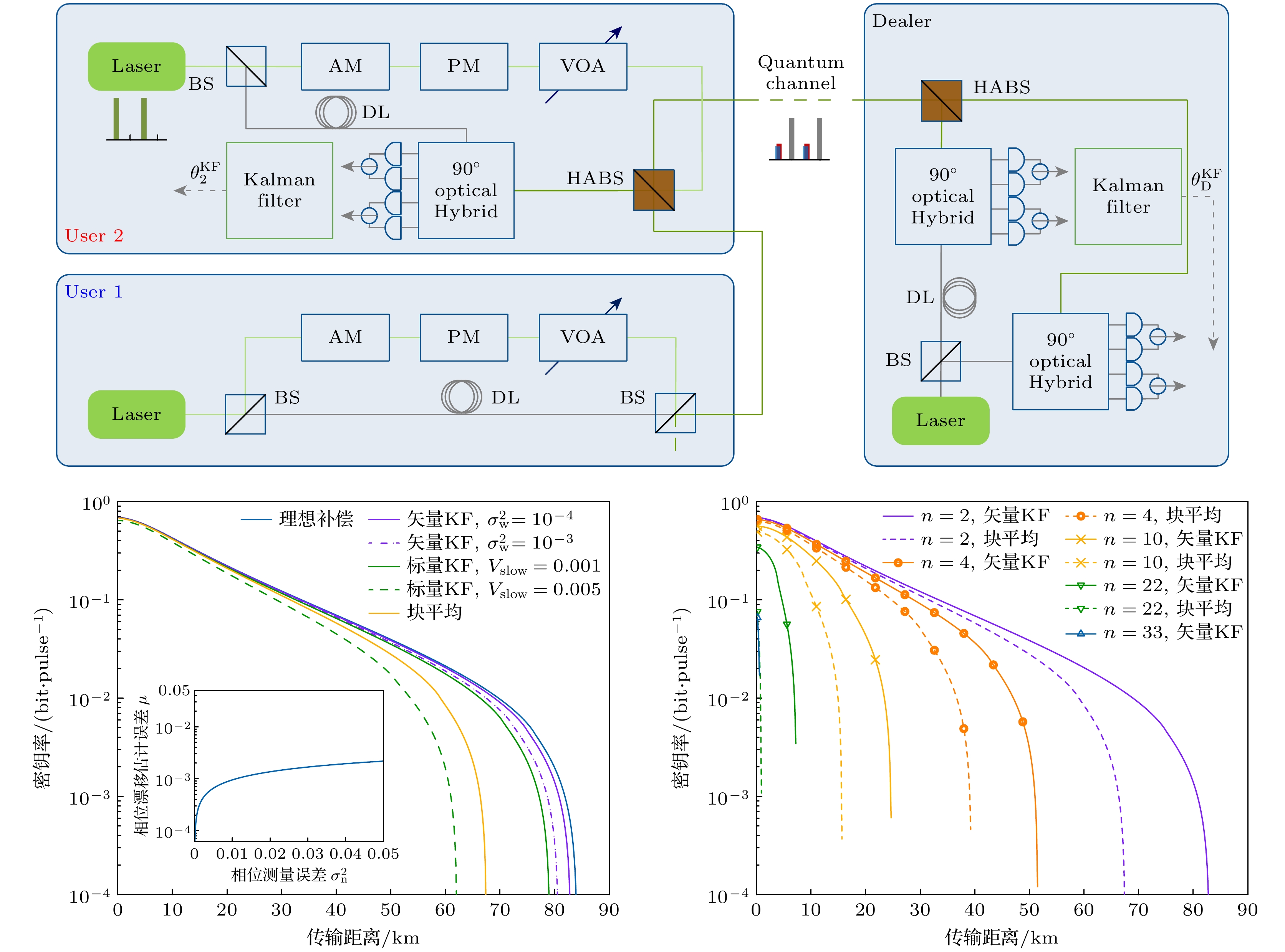


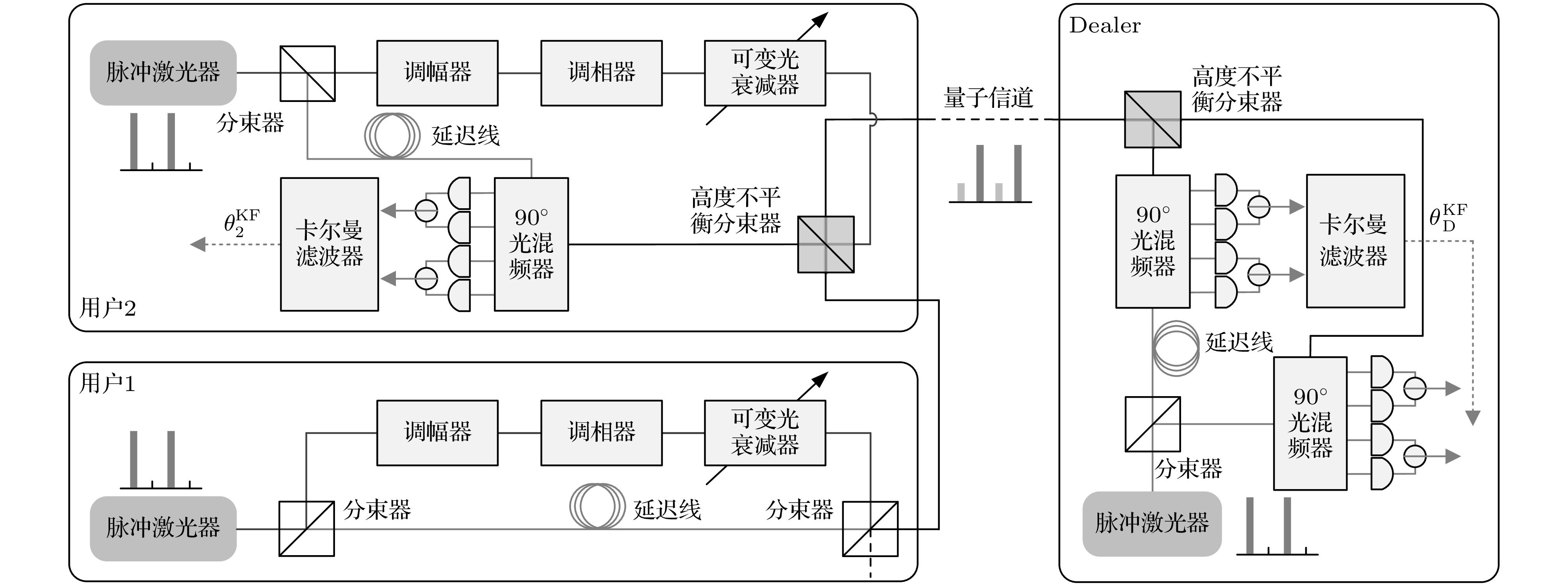
 下载:
下载:
